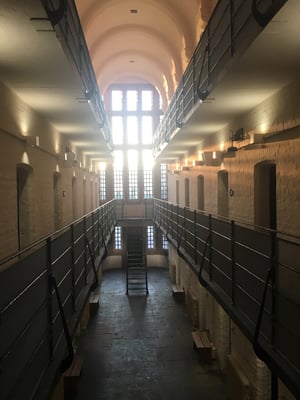08/11/2017
The theme of the 2017 BAVS Conference at Bishop Grosseteste University (BGU) was 'Victorians Unbound: Connections and Intersections'. Dr Pandora Syperek offers her thoughts...
 The ostensible theme of this year’s BAVS was the paradox between the parallel Victorian impulses to classify (knowledge, matter, people) into neat categories and to challenge established order and its inherent hierarchies through advancement and innovation. The goal was to consider what happens when the Victorians are ‘unbound’ from this seeming contradiction, instead granted the complexity to recognise that the one informed the other – the understanding of order and definition was necessary to blow it all apart and reorder and redefine. In order to do this we need to loosen the rigidity with which we have categorised the Victorians. In a way, this is a major thread running through my own research on the gendering of objects in the Natural History Museum, London: by looking at the less examined ‘jewel-like’ specimens on display—small, pretty, crafted, straddling art and science—and their resonance within the broader culture, I explore how categories of gender and genre were unstable and fluid.
The ostensible theme of this year’s BAVS was the paradox between the parallel Victorian impulses to classify (knowledge, matter, people) into neat categories and to challenge established order and its inherent hierarchies through advancement and innovation. The goal was to consider what happens when the Victorians are ‘unbound’ from this seeming contradiction, instead granted the complexity to recognise that the one informed the other – the understanding of order and definition was necessary to blow it all apart and reorder and redefine. In order to do this we need to loosen the rigidity with which we have categorised the Victorians. In a way, this is a major thread running through my own research on the gendering of objects in the Natural History Museum, London: by looking at the less examined ‘jewel-like’ specimens on display—small, pretty, crafted, straddling art and science—and their resonance within the broader culture, I explore how categories of gender and genre were unstable and fluid.
Like many Victorianists, I have been influenced by Michel Foucault’s History of Sexuality (1976) and its reconception of Victorian attitudes to sexuality and the epistemic implications. Foucault’s thesis in Volume 1 is that what has traditionally been characterised as the modern repression of sexuality, culminating in the notorious prudery of the Victorians—aka the ‘repressive hypothesis’—in fact reveals an explosion of interest in sexuality, hence the scientia sexualis of the late nineteenth century, which spawned the new field of psychoanalysis and the new ‘species’, the homosexual. Foucault’s notion that sexuality is a cultural construct had major impact, and followed on from his concept of the episteme—the historical conditions of possibility of a given discourse—as developed in The Order of Things (1966). Instead of the transition from sexual repression to sexual science, the latter focused on the transition from classical natural history to modern biology. While Foucault may no longer be the ‘hot’ theorist he once was, his ideas remain influential: I detected a strong Foucauldian thread running through the talks at BAVS 2017 and their unifying theme of Victorians Unbound. Here I will consider how the dual Foucauldian themes of sexual and natural science emerged—were unbound—in discussions of gender and ecology.
Ghosts of The History of Sexuality and The Order of Things haunted the keynote lectures and roundtables that in turn lingered throughout the panel sessions and in delegates’ consciousness, but the phantoms seemed to reconfigure themselves into new forms. Let’s call it Foucault 2.0. The opening round table highlighted the importance of things: Kate Hill argued that museum collections and their treatment disrupt Victorian boundaries, with the hierarchies of objects echoing those of people. Edwina Ehrman beautifully literalised the conference theme in her talk ‘Unlacing the Corset’. Interesting to me was that WH Flower, the second director of the Natural History Museum, campaigned against corsetry—in my paper a couple hours later I would describe how he campaigned against women’s adornment with exotic bird plumage. Who knew comparative anatomists were so concerned with women’s fashion? While the disfiguring of women’s bodies through corsetry might seem similarly cruel and barbaric to the murder of innocent birds, the museum director’s opposition points towards a counter-regulation of women’s activities and self-adornment. This despite the fact that he was personally responsible for the killing of numerous specimens. Meanwhile, non-corset-wearing women like female activists were seen as unfeminine. This is the type of complexity that requires unravelling in contemporary scholarship.
Mike Huggins’s jovial keynote on Victorian respectability established a running joke throughout the conference proceedings that carried with it a Foucauldian flavour. To understand the Victorian episteme(s), we need to acknowledge our own. While this may be an impossible task, asking historiographical questions of our work as Victorianists—e.g. why are we so obsessed with Victorian respectability? Why not Victorian unrespectability?—is essential for recognising how the current period and its concerns shape our vision of the Victorian era, and why it matters to us. The contemporary interest in the period in fiction and popular culture emerged in panels examining Steam Punk and NeoVictorianism, again questioning our relationship to the past via its representation in the present. The weight these areas were given marked an important development for Victorian studies and was fitting seeing as directly following the conference in Lincoln was a steam punk festival! These themes and Huggins’s talk set the tone for prioritising everyday realities and ‘low culture’ as much as high discourse. I’d have to say the most revealing experience for me was a tour of the Victorian Prison following the drinks reception on the beautiful grounds at Lincoln Castle—descriptions of cell conditions for inmates including children and women with babies, as well as public hangings, brought home some of the grimmest aspects of Victorian life.
As well as topics of gender and natural science, as an art historian I was drawn to the art and visual culture panels—luckily for me, a number of talks combined these fields. In the panel ‘Sex, Sexiness, Sexlessness: Problems of Eroticism in Victorian Classical Forms’, Rebecca Mellor and Melissa Gustin’s papers examined how queer sexuality can and has been both overemphasised and underemphasised, respectively, to the detriment of art historical narratives in the cases of Pre-Raphaelite painter Simeon Solomon and American Neoclassical sculptor Harriet Hosmer. The artists’ gender is implicated here, in that art historians have traditionally overlooked beauty as the embodiment of intellectual and spiritual ideals in Solomon in favour of an oversexed reading of homoeroticism, according to Mellor, while Gustin argued—in her excellently titled paper ‘Fifty Shades of Gay’—that conversely art historians have tripped over themselves to ignore and deny Hosmer’s lesbianism and its influence on her work. The consensus was to reclaim the queer gaze whilst broadening our conception of the erotic to go beyond the physical. While contemporary theories of gender and sexuality can facilitate new understandings of such material, a historicised conception of sexual categories, à la Foucault, is essential.
Also on the positioning of gender in between lived experience and representation, in their panel ‘Transgender’, Ann Heilmann, Billie-Gina Thomason and Rachel Egloff discussed transgenderism in Victorian lived realities and textual personae. A recurring problem was the privileging of ‘biology’ in both historical and current discourse—e.g. the Victorians’ determination of gender through breasts and external genitalia, and recent biographers’ insistence that James Miranda Barry was female, despite living as a man for over fifty years. As with the panel on queer artists, unpacking trans histories brings up important methodological questions for how we address these histories whilst, as Thomason urged, avoiding the problem of presentism—imposing our current understanding, or episteme, on the past. And yet this does not only comprise current debates such as those surrounding trans rights, but equally broader categories developed during the Victorian era, such as modern biology.
Subtler modes of categorisation were explored in panels such as ‘Decadent Spaces/Pleasurable Places’, which featured Joanne Knowles on the geographically and socially liminal space of the pleasure pier, Joseph Thorne on marginality and hybridity in Decadent cosmopolitanism and Giles Whiteley on the ‘curious effects’ of Wilde’s psychogeography. Rayanne Eskandari and Stuart McWilliams discussed the ‘Politics and Medievalism’ of John Ruskin and William Morris, respectively, and their paradoxes of authority and subversion in the case of Ruskin, and populism and scarcity in the case of Morris. In one of the few explicitly art focused panels, ‘Sculpture: Connections and Intersections’, Katie Faulkner discussed the gender and genre performance of Julia Margaret Cameron’s photography, as engaging with both sculpture and theatre to construct a particular vision of femininity. Jordan Kistler reconsidered evolutionism in Walter Pater’s theory of artistic development as representing a taxonomy based on the Lamarckian archetype, as promoted by Richard Owen (founder of the Natural History Museum) rather than an illustration of Darwinian progress. The implication, according to Kistler, is that in Pater’s formulation sculpture may come out favourably, as the epitome of art rather than its lowest form. In my own panel, simply titled ‘Objects’, Leonard Driscoll discussed things unrealistic but real in HR Haggard’s paratexts, taking the discourse of naturalism beyond the literary genre (which Haggard found rather ugly and smelly) to explore liaisons with archaeology. While the ‘connections and intersections’ between Leonard’s paper and my own on gendering taxidermied hummingbirds were not immediately obvious, parallels concerning the real or more-than-real and corresponding issues of taste and authenticity quickly emerged between these historically marginalised artefacts.
Throughout BAVS 2017 there was an emphasis on the everyday and its objects. As Kate Flint stated in her beautifully illustrated keynote on the cultural history of dandelions: the attention to the ordinary, commonplace and overlooked was one of the Victorians’ greatest contributions. This sentiment was echoed in the final President’s Panel speakers Katherine Newey’s enthusiasm for studying theatre with its liberating marginality and infinite materiality and Brian Maidment’s call for more studies of songbooks and almanacs and the need to experience archives in the flesh. This theme was fostered by, and in turn facilitated, a sense of fluidity or boundlessness of disciplines. And yet disciplinary demarcations were still apparent in different approaches taken, confirming there is still much to be learnt from one other. As a non-literary studies person, I felt like a tourist. But then again maybe that’s why I enjoyed it so much. The historian Peter Gay has written that Foucault’s ‘accustomed technique…of turning accepted ideas upside down’ is reminiscent of the principle underlying Oscar Wilde’s humour. This method is as relevant now as it was to the Victorians.
Pandora Syperek is a postdoctoral researcher who recently completed a fellowship at the Paul Mellon Centre for Studies in British Art. She is developing a monograph titled Jewels of the Natural History Museum: Gender, Display and the Nonhuman, 1851-1901. She received her PhD in the History of Art at UCL in 2015.
.png?width=400&height=162&name=BGU%20Logo%20(White%2c%20PNG%2c%20full).png)
